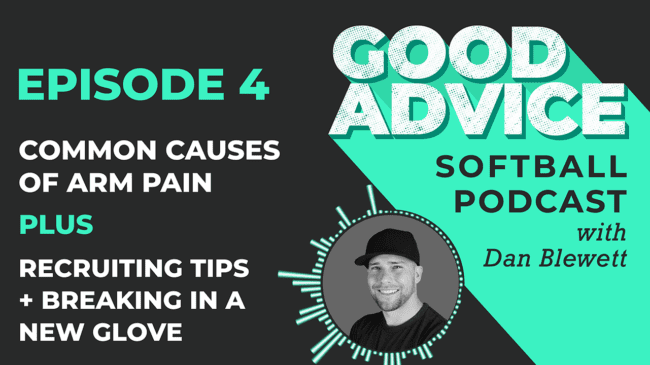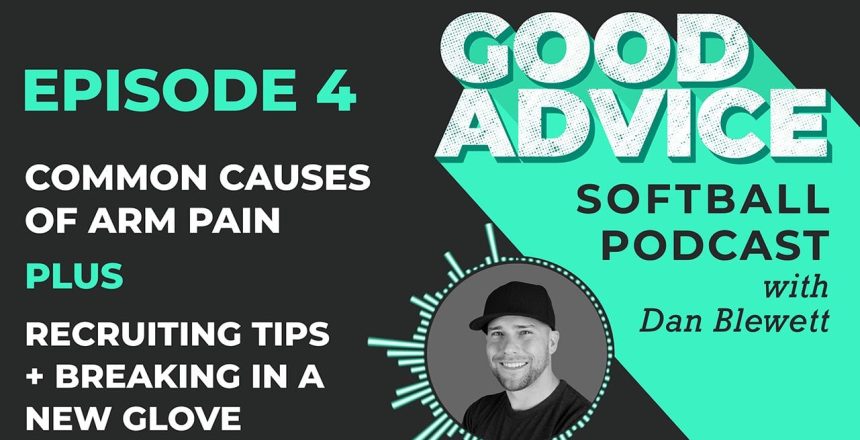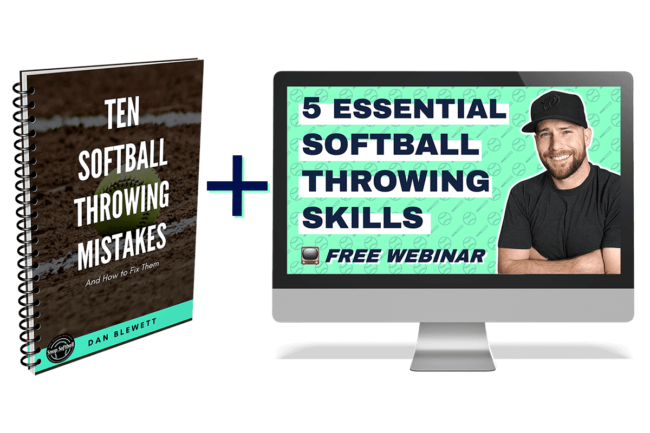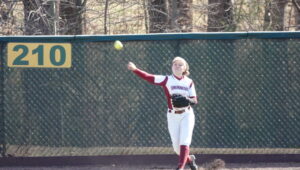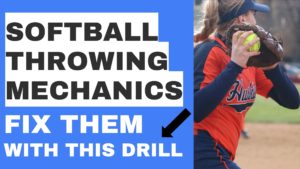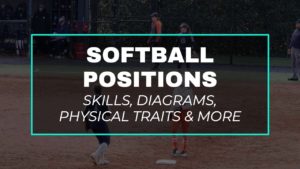*This article may contain product links which pay me a small commission if you make a purchase. Learn more.
Lots of softball players get throwing arm pain. Softball arm pain isn’t always preventable, but understanding the causes is an important step in getting proper treatment and reducing likelihood of injury in the future. We also discuss when a player is ready for the recruiting process to start, and how to best break in a new softball glove.
To submit a question for the Good Questions Q&A segment, make a voice recording and email it to Dan at hello@danblewett.com.
Want to support the show? Enroll in one of Coach Dan’s online throwing courses or his mental skills course. Use code GOODADVICE to save 20% on any course, just for being a listener.
Sign up for Dan’s Email list and get his free throwing eBook, and follow up with him on the interwebs: YouTube Channel | Twitter | Snapsoftball.com
Podcast: Play in new window | Download
Subscribe: Apple Podcasts | Spotify
Full Transcript: EP4 Good Advice Softball Podcast: Softball Arm Pain, Recruiting Advice and Breaking in a New Softball Glove
You are listening to the Good Advice Softball Podcast. I’m Dan Blewett. And on this show, you’ll learn how to help the softball player in your life. Sharpen her skills, improve her mindset and find new confidence through softball ball.
Hey, welcome back. I’m Dan Blewett and this is the good advice softball podcast. In today’s episode, we’re going to cover, where does arm pain come from when throwing? So this could be elbow pain. This could be shoulder pain, but the, the root causes for most players. Are relatively, relatively consistent, I would say.
So number one, the, by far the biggest one is just a lack of shoulder stability. And what that means is, so your shoulder, if you’re not aware is one of your looses joints in your body can compare this to your hip joint. For example, which is extremely difficult to dislocate is extremely deep, has a very deep socket.
So imagine if you had a, like a baseball or tennis ball in your hand, You could fit most of that ball in your hand by, you know, just, just wrapping your fingers around it. That’s like your hip socket, your, your bones cover the ball and socket joint of your hip very well in your shoulder. It’s a lot more like a golf ball sitting on a tee, your shoulder, socket, your shoulder, as it, as the ball sits in this, in the socket joint is very, it’s just very shallow.
And that’s what gives you so much. Room for motion. That’s how your shoulder can go all the way overhead and all these different directions and move in a circle and do all this crazy stuff. So with that extra stability comes a price that basically one of the big problems with the young athletes, boys and girls is that they’re just not super strong and well conditioned.
And this is where strength training, really is important because it good strength training program is arm care, essentially. So basically the formula for keeping away some elbow and shoulder pain is having a shoulder that is strong and stable. So this is again, I highly recommend, for any athlete above probably the age of 11, who’s ready to do it mentally.
They should be in a good strength training program that focuses on whole body. strengthening upper body strengthening is important, pushing and pulling exercises, like pull ups and rows and chin ups and pull ups. And with all also a rotator cuff component to it. So the rotator cuff is the group of muscles that is predominantly tasked with stabilizing the shoulder.
So these are all the really boring, tedious arm care exercises that you would do. You know, the external rotations, the raises have little one pound, two pound dumbbells. Those are important because they feed into stabilizing your shoulder. And when your shoulder is stable, it. Just isn’t going to bounce around.
Shoulder Stability is Critical in Preventing Softball Arm Pain
It’s not going to get pulled in any different direction. It’s just going to be in the joint. The way the joint was was designed essentially. So the number one problem, probably the number one cause of arm pain for young players is this shoulder instability. They just don’t have a lot of strengths are their shoulder joint is loose.
And when your shoulder joint is loose, it kind of bounces around. Just like anything else. So if you had a loose bolt in your, in your car axle or your tire or your wheel, well, not your tire. you know, if you’d have loose bolts or loose, loosely made parts in a car, what would happen? It would eventually tear itself apart, right?
same goes for any machine machines are made well with tight tolerances. It means the parts fit together very well. And that’s the same thing with your shoulder. So number one is, is shoulder stability and to improve that a good strain of conditioning regimen. And a focus also on rotator cuff strengthening, which is quote unquote called arm care.
So that should be a focus. If you’re, if your daughter’s having arm pain really looked at strength and conditioning. Number two, is overused, but here’s how I’m gonna kind of talk. Cause overuse is boring to talk about. We all, we all get it. You play six games in a weekend tournament. You’re going to throw 700 throws in that weekend.
It seems pretty logical that your arm might hurt. Cause it’s just, it’s just way too much repetitive motion. so the way to get around this is just to sort of conserve bullets and pregame. just to be a little more regimented as, as coaches about how much they’re throwing in practice or in pregame.
and that can just be bucket brigade. So if you’re hitting your players a ton of a ton of ground balls, which you should be on a midweek practice, You know, maybe after they warm up and they’ve taken a couple of CR that they’re gonna throw across a diamond, you’re going to just drop the rest of them into a bucket so they can get their fielding and their foot work and their glove work.
But they’re not going to be taxing their throwing arm constantly. Also. It’s good to let your kids sit on the bench a little bit. You know, I don’t like these rosters where players, you know, you have like 10 kids on a, on a team. And so everyone’s playing every inning of every game. That’s not a great longterm recipe players, a Nita mentally learn how to sit on the bench and cheer on their teammates because that’s how it’s going to be in college in high school and college at times.
So they need to learn and getting their body. Some rest is a good thing. So. You know, I, I get that the best players are gonna play six out of six games in a weekend, but it’s not a bad thing. If your best player sits a game so that someone else can get their turn, the sun and be in those pressure situations.
So, you know, just being judicious about playing time and realizing that sitting at game is good mentally and physically, I think that’s an important mindset to have. The other thing is conflicting sports. And the biggest one that I found, because lots of girls play volleyball. Is is that that overlap in the winter when they’re playing volleyball and they’re throwing and they’re starting to get ready for the season.
That is a, it’s an incredible amount of repetitive motion. It’s very different. and it’s really a bad cocktail. So we had lots of, of, of softball players who played volleyball, in my time owning my Academy. And when they’d start to get barky, shoulders and barky elbows were like, how much volleyball are you playing right now?
They’re like, well, four days a week. Exactly right. How, how would their arm not hurt when they’re playing volleyball and whacking, volleyball’s overhead, you know, a hundred, 200 reps a night. Sometimes it can be crazy with some of these really good competitive clubs that practice, practice, practice. And, it’s something to really consider that this can not only.
Cause arm pain, but this can definitely be the road to an injury. Cause lots of volleyball players do end up injuring their shoulders. It’s a very hard, repetitive motion sport and it has the added impact, you know, in softball, the balls in your hand and you throw it in releases, in volleyball, the ball is not in your hand, you whip your arm through and then you smack it.
So that collision is a, is very different. It’s very unique. And, it’s just putting a lot of stress on the shoulder when you’re trying to do both at the same time. So be careful with that. volleyball and softball can be a tough mix on the, on the throwing arm with elbow pain. It’s typically coming from the shoulder.
And this is something that you learn in baseball when your shoulder is not. Doing well on this con comes back to your training, being in shape, having a strong stable shoulder. So that shoulder stability, when your arm is not in good shape, the pain sort of flows down the rest of the chain. And so your elbow is down the chain from your shoulder.
So if your shoulder is just getting worn out, because it’s not in good shape, you don’t have an arm care regimen. You don’t have a good strength and conditioning regimen, and you’re really overused. Your elbow pain is often a result of your shoulder being so worn out that your mechanics start to change for the worse as you get tired.
And then more stress gets put on the elbow. So a lots of times elbow stress is related to shoulder stress. The other thing with elbow pain is that girls don’t really throw hard enough to tear their UCL like baseball players do. I mean, that’s essentially a fact, football players don’t typically tear their UCL, which is the ulnar collateral ligament, which is in your elbow, which is the ligament that controls your arm.
As it goes back, it kind of is the limiter not letting it just fly off. And so that UCL is subject to lots of stress and that’s what baseball pitchers get when they, they tear it overtime. So it’s called Tommy John surgery and I’ve had it myself. So the elbow stress is highly correlated with velocity. So having the lighter ball.
And the bigger, stronger men, they can throw that thing, you know, but up to a hundred miles per hour. So they’re putting a lot more stress to the UCL, but softball players, because the bigger, heavy ball there, they’re lesser strength in general, you know, the hardest throwing softball players in the world might get up to 75 miles per hour across the diamond.
And that’s extremely rare. So the forces are just lower, but elbow, elbow pain is still pretty prevalent. So this is going to be mechanical. It’s also going to come from the shoulder as I just discussed a butt. Elbow pain is, is. It’s not directly tied to any given mechanics. So I know some players say, Hey, when I throw side on my level pain, it’s not necessarily because you throwing sidearm and you can see this just in, in practice, all baseball infielders, throw sidearm almost all the time.
And there’s some of the healthiest throwers on the field are much healthier than, than pitchers and much healthier, healthier than out in the outfielders. and I think the varied arm angles help. It just depends on your mechanics. So I wouldn’t demonize. And this is the big takeaway with this part. I wouldn’t demonize.
Throwing from sidearm or throwing over hand. I would just look at the entire set of mechanics as a whole, because typically if your elbow pain, if you have elbow pain throwing from sidearm, it’s because your mechanics throwing the ball side arm are poor. Whether your front shoulders opening up too soon, your hips are opening up too soon, or elbows really dipping, whatever it is, bad mechanics are going to be at fault, not the given arm slot.
So if you do have pain throwing from one arm slot versus another. It’s not going to be the arm slots fault. It’s going to be your mechanics as you get into that arm slot, and most players, when they throw sidearm, they’re not throwing side arm, like the baseball guys do intentionally. A lot of times the softball players were throwing sidearm.
Accidentally because their mechanics are poor. And so that’s the big distinction. It’s not really sidearm, that’s causing a problem. It’s the mechanics that are causing you to throw a sidearm and that’s a big distinction. And then the other thing that I think is really important is just to have a good throwing regimen in general.
And this means slowly building up the season and then, you know, maintaining a level of conditioning through both again, arm care, your strength training. And a, and a consistent throwing routine, lots of players go right into their season and they’re going from very little throwing to throwing five days a week, you know, and tons and tons of games.
And that’s just a recipe for disaster. So make sure as a coach, you’re really ramping your players up to get them ready for the season. And this is something pitchers do really well, but of course in softball, pitching is a completely different motion. And then obviously in baseball, this is something that baseball guys do really, really well because they have to, because they get injured so much that they learn to be better with this stuff.
But I think sometimes because softball players don’t get really injured, throwing, they get pain more than they get injured. I think, you know, sometimes the subject is overlooked because you’re not seeing the catastrophic injuries as a coach. When a bunch of your players go down for surgery. Then you really start saying, man, we might need to do something different, but that doesn’t happen as much as in softball.
And so I think a lot of the times the poor routines maintain. Because there’s not a big of a consequences, but I’ll tell you from experience when a player gets hurt and gets a surgery, a it really tears your heart out as a coach. And it certainly makes you go back to the drawing board and try to see what you could do better.
so that’s something to think about as well. The last one I’ll touch on is growth plate growth plate pain is very, very common in young players and it’s, it’s not something you can really get around. Players are growing, they have open growth plates. And when you put a lot of stress through that elbow, It’s going to hit that growth plate.
And so some players will just get really, really aggravated growth blades. And this is going to be pain like right on the bone. And this is something that no amount of arm strengthening is going to fix. You’re just going to have to take time off and you can essentially, this is, and again, this is a conversation for your doctor.
Don’t do it. What I’m, I’m not giving you any advice here about what to do about it. Just be aware that. Elbow pain with young players and that’s up to probably 17 is pretty common. And so when you have elbow pain as a young player for me and my Academy, that was often we’re saying, okay, maybe it could be a growth plate thing.
Maybe it could be a shoulder thing. Let’s send you to the doctor, get you looked at, have him take x-rays because you wanna see, and they’ll be able to see through x-rays whether you have some inflammation on that growth plate, or if you have a fracture in general, because the growth plate is softer. It’s not fully formed bone.
And so that’s typically the weak spot in the bone, and this is something to be really careful about because if you. Your daughter has some elbow pain and it goes untreated and she continues to have it, that elbow, you know, right where that growth plate is, the tip of the elbow can break off. And I’ve seen this a number of times.
you can Google it, like it’s called a medial epicondyle fracture. And, it’ll it just like the little tip is just cracked and is floating underneath the skin. And they have to put screws down and shoot screws all the way into the bone to pin it back into place sometimes, when it’s not as bad as it was healing its own, but it can be a really long lengthy process to come back.
And that’s something that can be completely avoided if you listen to the elbow pain and you get rest quickly and take time off rather than continue to push it. So my advice is no matter what happens, listen to the body. Don’t ignore elbow or shoulder pain. It’s a sign that something’s wrong and that something needs to change.
And especially with elbow pain, be concerned that it could be growth plate. If you have a young, a young player, who’s somewhere between, you know, eight and 17 where they don’t have close growth plates yet, it’s something, again, that’s not it’s bitten players who are very well conditioned in my Academy. In the past, we typically had one or two of them a year, and this is over a flock of 120 kids.
We usually have like one or two growth plate problems a year. And usually it wasn’t a fracture use. It was just, Hey, I got to take four to six weeks off. So it says the doctor, because my elbow hurts and they said, I’ve got an inflamed growth plate, but we have had fractures. And, sometimes they’re unavoidable and it’s not like you can have some sort of training regimen that just prevents growth plate injuries.
It’s just, again, it’s a bony thing. And it’s something that happens with young players who are growing. So. Be cautious with that. And again, my advice, overarching advice is if you have pain, then it should be addressed. And that should be first, Hey, let’s take a week off and see how it goes and slowly ramp back up.
Cause most stuff is just, it gets a little barky and not everything is caused from major concern, but after we give it, doesn’t go away. Then you should certainly see a doctor and just get it checked out and better be better safe than sorry, because again, if it’s something like a growth plate, inflammation that can really escalate.
And with any of these injuries, you know, something that could be wiped away with a week or two arrest quickly becomes a four to six weeks of rest thing. And then a four to six week ramp up to get back in the shape. And that’s your whole season gone. So be really careful when it comes to armpits.
Alright, so today’s 92nd mindset is it’s for the whole family. And this is when should I start the recruiting process? And this is something that if you’re out there and you’re in the, the recruiting camp world, the recruiting profile world, the recruiting, I don’t know if you just, you’re going to get a lot of emails when you start to sign up for some of this stuff from people saying start the recruiting process early.
It never too early to start. Well, it’s certainly there certainly is a time. That’s too early to start. So really the time to start the recruiting process is when your daughter is about physically there. Where you could look, you go to a D one game or go to a D three game or go to a Juco game. All those girls are very physical.
There’s not nearly as much of a difference as there used to be a go to a game and look at the physicality of the girls who play that position. So if she’s a catcher, we’ll look at the catchers. She’s a third basement. Look at what a third baseman at division two softball looks like. And then look at your daughter.
Is she five, 10 and 165 pounds and looks very fit and muscular and athletic, or is she five, two? And it looks kind of wirey and, you know, she’s kind of new to strength training and just like, isn’t really that strong yet. If that’s the case, that’s exactly what a recruiting or a recruiter is going to see, you know, recruiting coordinator from a college, they’re going to say, Oh, okay, nice player, good skills.
Well, we’ll check back in a year or we’ll check back in two years. So you have to take a long look at what, what your, your daughter’s doing and where she’s at physically. And. One way to figure this out is actually to send her to some local college camps. And these are the cheaper ones. So if you live in Iowa, university of Iowa is going to put on a, you know, a camp every year and it’s gonna be low cost.
It’d be like 50 to 150 bucks, something like that. And these are ones where they can get their feet wet and not have this big anxiety about going to. Do a camp and getting in front of coaches, it’s kind of a good way to break them in, or it’s not like one of these three or $400 expensive cattle calls where they can be a lot of coaches watching and a lot of pressure.
So those are good because it will be the first time where they can see a, what college players look like up, up close, because there’ll be working the camp. They’ll see other players who are farther along in their recruiting process, who are maybe serious prospects for these schools. And they just get a chance to like kind of weigh in and see how they fare against other players.
So I think the local schools are great even for a young player to just get their feet wet and start to compare themselves to other players. But when you’re starting to talk about taking major recruiting trips, spending major money on travel softball, and like these big tournament’s on any of that stuff or spending a thousand dollars on a service that promises you a, you know, recruiting profile and all these things.
You really need to ask yourself if someone looked at her today, would they have any chance of offering her anything? And if the answer is no, then I would wait. because they’re not going to be following you nearly as much as you think they’re going to be being very time efficient, beating the recruiting trail, going to see players that they might offer that day they might offer next week that they might offer, you know, in two weeks from now, or have, have, over to their campus for a visit when they’ve got money to go spend on a player.
They’re ready to spend it. And so they’re looking for, okay, who’s a two 20, 23, or who’s a 2021. Then I can go get a, if your player’s just really far from that, it’s just not going to be a fruitful endeavor. So I always recommend saving your money, getting someone who you trust, and this could be a local coach or whatever.
Hey him, say, Hey, can you evaluate my daughter, pay you a hundred bucks for an hour of your time, whatever it is, give us some very honest feedback about what she, where she is today. Where she maybe fits in and then who she could be if she works hard, like what should we should do and how far away she is from, you know, being a serious recruit that is really, really important.
Having a good idea of where you are today. So you can create the stepping stones to where you want to be. If you, if you live in this illusion land, like many players and parents do have my is going to be Dijuan and she’s here and she’s already the best player on the team, and this is how great she is.
You’re not going to take the time and care to make a thoughtful training program, to really get her where she needs to go. So be find someone who will be blunt and honest with you, who will say, Hey, this is how good your daughter actually is. And this is how much improvement she needs to make to be what you all want her to be.
That’s a really important, helpful discussion so that you can make a good roadmap to get her where she wants to go.
All right. So today’s question. I did not get a voice question, so I’m very sad about this, but I did get an email question a while back that I wanted to answer. So please help me out. If you have a question that you’d like answered live on the show, send me a voice recording to hello@danblue.com. And I will answer it here on the good advice softball podcast.
So today’s question is what is the best way to break in a glove? And so this is, I think really important because let’s cover two quick things. Your number one. Finding the right fit. Glove is a really important thing. So if you’re an outfielder, you should definitely have a outfielders met. And that seems super obvious and boring advice.
But I can’t tell you how many times on the boast on both the baseball and softball side outfielders have an infielders glove, infielders have a. An infielders glove. They just don’t have the right tool for the job. So I think it’s a worthwhile investment, especially if you are as an outfielder that you should have an Outfitters meant.
That’s a little bit, probably longer fingered, and that’s going to be important from, you know, flagging down a ball deep into the hole or deep into the gap. Or she’s going to be out stretch that extra little bit of reach makes a really big difference. Also make sure it’d be different on a diving play. It just keeps it in there a little bit better.
I know softball gloves are big in general, but you want to find something that’s well suited for the positions that she plays. Miss can really make a difference. as far as breaking in gloves, what you don’t really want to do is if you’ve paid a lot of money for a nice expensive Mitt, and that’s probably in the $200 and up range.
They’re going to come with harder leather. It’s going to be stiffer. And that’s a good thing because it’s going to hold its shape once you finally break it in. So what you really don’t want to do is put it in one of those ovens where you know, they’re going to steam it, because what that does is it basically just makes that stiff from good leather into soft leather.
Which is always a hundred dollars, cheaper, $150 cheaper. You basically pay for the stiffness and the quality of the leather. And so if you take your time and care to break that in slowly, just through playing catch and through, you know, a little bit of oil and through beating it with a mallet stuff like that, to help form the pocket.
Then it’s going to be a glove. That’s going to stay with you for a lot longer, but if you steam it, it gets floppy. It’s not going to hold its shape. And now you really can’t do the same thing as that you would do with it, especially for infielders having stiff pinkies and thumbs is really important for like a backhand play in the whole having a little bit of rigidity.
Can keep the ball in near Mitt instead of a glancing off and sort of the ball pushing the mud out of the way, rather than the Mitt forcing the ball to curl into it. So these are things that high level players do. And it’s definitely harder, especially for girls who are younger, who have small hands it’s, it’s tough for them to break in.
And expensive Mitt because the leather is so hard. And you see on the baseball side too, the baseball boys own always want to get that expensive $250 Mitt. And they have really hard leather and a little kid can’t squeeze that glove enough to really break it improperly. So if you do spend a good amount of money on a glove, that’s going to last, I applaud you, but you also have to take the time to break it in.
Right. And that’s going to probably mean you either need to go to the batting cage and catch a lot of balls. Because high velocity throws are, what’s going to break into the best and fastest and the most naturally. And if you’re always playing catch with someone who throws 40, 45 miles per hour, like a lot of 13, 14, 15 year olds do, it’s not going to break that men in very well.
So finding someone or some thing to help break that mid in, whether it’s a pitching machine or maybe your mom or dad throw fuel and they can throw a lot of babies at you. Or playing catch with a brother or whatever. Those are important things. also taking a lot of fly balls will help break the midden cause there’s a higher impact.
But far and away, the way that all the pros breaking their myths is through playing catch and some glove conditioner. And a, and that, again, that just means like a little bit of oil and the break points. And I’d highly suggest that you check out my YouTube channel. Cause I do have a video on how to break in a glove and, there’s a little bit of art and science to it, but it’s really important.
And I think this is something that, you know, players, this is their tool and you should take care of it. And so parents, I wouldn’t spend a lot of money on a glove until your players are willing to clean it and take care of it and break it in the right way. And if you do spend a lot of money on a mint, you should take the time and care to break it in naturally through playing catch.
Beating it with a mallet to shape it a little bit. And then just, using a little bit of glove conditioner to help soften some of the break points. But again, don’t put it through the steamer, take your time. And this also comes back to timing. So if you really want a glove to be ready for the season, give it four months before the season grabbed the new gloves.
I know Christmas is a great time for, for new glove presence, but you know, that only leaves you sometimes two months to get it ready. And that can be tough depending. So plan ahead and I wish you luck with your new ball glove.
Well, that’s all the good advice I’ve got for today. If you enjoy the show and would like to support me while also helping yourself enroll today. And one of my online softball courses, my she’s got a Canon throwing courses come with pricing plans for any budget. And my resolute athlete, mental skills course will help your daughter or team build the mindset of a champion.
Enroll in any of my courses through the links in the show notes and save 20% with code good advice just for being a listener. Be sure to subscribe to my weekly email list where you’ll get updates on all my new videos and episodes, nearly 4,000 people get my emails and you should to sign up for the link in the show notes.
Lastly, who do you know, who can use some good advice? Please share this podcast with a friend, subscribe on iTunes, Spotify, or wherever you listen to podcasts and subscribe to my snap softball, YouTube channel, where you’ll find this podcast and hundreds of softball, instructional videos. Back when I was a player, I was always thankful for good coaches and good advice.
I’m Dan Blewett and I’ll see you next time.

